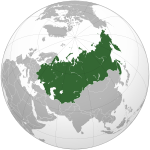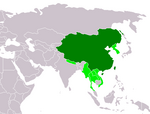Legnagyobb birodalmak listája
A történelem legnagyobb birodalmainak listája terület szerint rendezve.
A lista[szerkesztés]
| A birodalom neve | Terület (millió km²) |
Összefüggő terület? |
Térkép | Maximumának ideje |
Népesség (millió) |
a világ népességének százaléka |
|---|---|---|---|---|---|---|
| Brit Birodalom | 35,5 [1] | TAGOLT TERÜLETŰ |

|
1920 [1] | 531 millió (1938-ban)[2] |
23,1% [2] |
| Mongol Birodalom | 24,0 [1][3] | 
|
1270 [3] vagy 1309[1] | 110 millió (XIII. század)[4] |
25,6% [5] (XIII. sz.-ban) | |
| Orosz Birodalom | 22,8 [1] | 
|
1867 [1][3] | 176 millió (1913-ban) |
9,8% | |
| Szovjetunió | 22,3 [1] 22,4 [6] |

|
1945 [1] — 1991 | |||
| Spanyol Birodalom | 20,4 [7] | TAGOLT TERÜLETŰ |

|
kb. 1740-1790 [8] | 68,2 millió [9] | 12,3% [10] (XVII. század) |
| Csing-dinasztia (Kínai Birodalom) | 14,7 [1][3] | 
|
1790 [1][3] | 432 millió (1851-ben)[11] |
36,6% (1820-ban)[10] | |
| Orosz Cárság | 14 [1] | 
|
1689 | |||
| Második francia gyarmatbirodalom | 13,5 [12] | TAGOLT TERÜLETŰ |

|
1920 [12] | 150,8 (1938-ban) | 6,9% |
| Omajjád Kalifátus | 13,2[1][13] | 
|
720 - 750 [3] | 62 (VIII. század)[14] | 29,5% [15] | |
| Abbászida Kalifátus | 11,1[1] | 
|
750 [1] | 20,0% [10] | ||
| Jüan-dinasztia (Kína) | 11,0 [1] | 
|
1310 [1] | 86 (1290-ben)[16] | ||
| Portugál Birodalom | 10,4 [13][17] | TAGOLT TERÜLETŰ |

|
1815 [8] – 1849 [17] | ||
| Első francia gyarmatbirodalom | 10,0 [18][19] | TAGOLT TERÜLETŰ |

|
1680 | 30 (1680-ban) | 5% |
| Imperialista USA | 9,8 [1] | TAGOLT TERÜLETŰ |

|
1899 | ||
| Brazil Birodalom | 8,5 | 
|
1880 [8] | |||
| Japán Birodalom | 7,4 | TAGOLT TERÜLETŰ |

|
1942 [8] | 134,8 (1938-ban) | 5,9% [10] |
| Han-dinasztia (Kína) | 6,5 | 
|
100 [20] | 74,0 [16][21] | 26,0% [10] | |
| Ming-dinasztia (Kína) | 6,5 | 
|
1450 [1][22] | 110 (1600-ban)[23][24] | 28,8% [10] | |
| Rásidún Kalifátus | 6,4 [1] | 
|
655 [1] | 19 % | ||
| Harmadik Birodalom | 6,4 | 
|
1942 | 75,4 millió (1938-ban) |
||
| Arany Horda | 6,0 | 
|
1310 [1][22] | |||
| Türk Birodalom | 6,0 | 
|
557 [20][22] | |||
| Óperzsa Birodalom | 5,5 [25] | 
|
Kr. e. 480 [26] | 49,4 (Kr. e. 5. század)[27] |
44,0% [28] (Kr.e. 5. század)[27] | |
| Ujgur Kaganátus | 5,5 | 
|
800 [1][22] | |||
| Tang-dinasztia (Kína) | 5,4 | 
|
715 [22] | 53,0 (755-ben)[16][29] |
28,0% [10] | |
| Szeleukida Birodalom | 5,2 | 
|
323 [22][30] | |||
| Oszmán Birodalom | 5,2 | 
|
1683 [1][22] | 7,1% [10] (XVII. század) | ||
| Római Birodalom | 5,0[25] | 
|
117 [31] | 80,0 (II. század)[32][33] |
35,9% [32] | |
| Maurja Birodalom | 5,0 | 
|
Kr. e. 250 [22] | 50,0 | 33,3% [34]) | |
| Északi Jüan Kánság | 5,0 | 
|
1550 [1] | |||
| I. Mexikói Császárság | 4,9 | 
|
1822 | |||
| Hszin-dinasztia (Kína) | 4,7 | 
|
10 [20] | |||
| Tibeti Birodalom | 4,6 | 
|
800 [1][22] | |||
| Timur Lenk birodalma | 4,6 | 
|
1405 [1][22] | |||
| Mogul Birodalom | 4,6 | 
|
1690 [1][22] | 175,0 (1700-ban) |
29,2% | |
| Fátimidák Kalifátusa | 4,1[1][3] | 
|
969 [1][3] | |||
| A hsziungnuk birodalma | 4,03 [35] – 9,0 [36] |

|
Kr. e. 176 [37] | |||
| Hun Birodalom | 4,0 [38] | 
|
441[20] |
Jegyzetek[szerkesztés]
- ↑ a b c d e f g h i j k l m n o p q r s t u v w x y z aa ab ac Taagepera, Rein (1997). «Expansion and Contraction Patterns of Large Polities: Context for Russia». International Studies Quarterly (Institut National d'É) 41 (3): 492-502. JSTOR 2600793
- ↑ a b Harrison (1998, p. 3,7).
- ↑ a b c d e f g h Turchin, Peter et al. "East-West Orientation of Historical Empires". Journal of world-systems research. 12 (2): 222–223.
- ↑ La población combinada de China y Corea en el siglo XIII fue de 83 en Biraben (2003Sablon:Cite requerida). La población combinada de Europa Oriental, Rusia, Asia Central, Irán, Irak y Turquía fue cercana a los 27 en Maddison (2006Sablon:Cite requerida).
- ↑ Sablon:Cite publication
- ↑ СССР. Введение — Большой советской энциклопедии (Nagy szovjet enciklopédia)
- ↑ Roca Barea, María Elvira. Imperiofobia y leyenda negra: Roma, Rusia, Estados Unidos y el Imperio español. Siruela, 2016. Sección 7.
- ↑ a b c d Gordon (2005)
- ↑ La población combinada de España, Portugal, Italia, Países Bajos, Estados Unidos y las Filipinas fue 29,2 en Maddison (2006). La población de América Latina fue 39 en Biraben (2003), menos Brasil y sus 4 millones que fueron parte del Imperio portugués.
- ↑ a b c d e f g h Maddison, op cit. Para estimativos alternos, ver la herramienta de búsqueda de USA/UK Economic History Services. Archiválva 2012. január 18-i dátummal a Wayback Machine-ben
- ↑ El número de personas registradas en 1851 es 432 164 047 de acuerdo a Draft History of Qing.
- ↑ a b Herbert Ingram Priestley, France overseas: a study of modern imperialism (1938) pp 440–41.
- ↑ a b The Largest Historical Empires. [2016. március 3-i dátummal az eredetiből archiválva]. (Hozzáférés: 2022. február 17.)
- ↑ La población combinada del Suroeste de Asia y Norte de África fue cercana a 57 en Biraben (2003Sablon:Cite requerida). La población combinada de España y Portugal fue cercana a 5 en Maddison (2006Sablon:Cite requerida).
- ↑ McEvedy and Jones (1978)
- ↑ a b c John D. Durand, 1960, "The Population Statistics of China, A.D. 2–1953," Population Studies Vol. 13 (No. 3), 209–256. (b) John D. Durand, 1974, "Historical Estimates of World Population: An Evaluation," University of Pennsylvania, Population Center, Analytical and Technical Reports, Number 10.
- ↑ a b "Cesare Marchetti and Jesse H. Ausubel" "The Rockefeller University" "Academic school book" "date:2013" "Quantitative Dynamics of Human Empires"
- ↑ Robert Aldrich, Greater France: A History of French Overseas Expansion (1996) p 304
- ↑ Melvin E. Page, ed.. Colonialism: An International Social, Cultural, and Political Encyclopedia. ABC-CLIO, 218. o. (2003). ISBN 9781576073353
- ↑ a b c d Rein Taagepera "Size and Duration of Empires: Growth-Decline Curves, 600 A.C. to 600 D.C.", Social Science History Vol. 3, 115-138 (1979).
- ↑ El número de personas y hogares registrados en 2 d.C. fueron 59 594 978 y 12 233 062, respectivamente, de acuerdo a Scheidel (2005, p. 37) y Yoon (1985, p. 211-212).
- ↑ a b c d e f g h i j k Peter Turchin, Thomas D. Hall and Jonathan M. Adams, "East-West Orientation of Historical Empires Archiválva 2007. február 22-i dátummal a Wayback Machine-ben", Journal of World-Systems Research Vol. 12 (no. 2), pp. 219-229 (2006).
- ↑ Jean-Noël Biraben, "The History of the Human Population From the First Beginnings to the Present" en Demography: Analysis and Synthesis: A Treatise in Population (Eds: Graziella Caselli, Jacques Vallin, Guillaume J. Wunsch), Vol. III, Chapter 66, pp 5-18, Academic Press:San Diego (2005).
- ↑ El número de personas y hogares registrados en 1393 fueron 60 545 812 y 10 652 870, respectivamente, mientras el número de personas y hogares registrados fueron 66 598 337 and 11 415 829 en 1403, respectivamente.
- ↑ a b Turchin, Peter; Adams, Jonathan M.; Hall, Thomas D (2006). "East-West Orientation of Historical Empires" (PDF). Journal of World-Systems Research. 12 (2): 222. ISSN 1076-156X
- ↑ Vasseghi, Sheda, "The other Iran story: Re-engineering the nation's cultural DNA", Breaking... WorldTribune.com World Tribune News, (12 October 2009).
- ↑ a b Mientras las estimaciones tienen un rango entre 10 y 80, la mayoría prefiere 50 . Prevas (2009, p. 14) estima 10 1. Langer (2001, p. 40) estima alrededor de 16 2[halott link]. McEvedy y Jones (2001, p. 50) estiman 17 3. Strauss (2004, p. 37) estima cerca de 20 4. Ward (2009, p. 16) estima también 20 5. Aperghis (2007, p. 311) estima 32 6. Scheidel (2009, p. 99) estima 35 7. Zeinert (1996, p. 32) estima 40 8. Rawlinson y Schauffler (1898, p. 270) estiman posiblemente 50 9. Astor (1899, p. 56) estima casi 50 10. Lissner (1961, p. 111) estiman posiblemente 50 11. Milns (1968, p. 51) estima un poco más de 50 12. Hershlag (1980, p. 140) estima cerca de 50 13. Yarshater (1996, p. 47) estima 50 14. Daniel (2001, p. 41) estima cerca de 50 15. Meyer y Andreades (2004, p. 58) estiman casi 50 16[halott link]. Pollack (2004, p. 7) estima aproximadamente 50 17. Jones (2004, p. 8) estima más de 50 18[halott link]. Safire (2007, p. 627) estima 50 19. Dougherty (2009, p. 6) estima cerca de 70 20. Richard (2008, p. 34) estima casi 70 21. Mitchell (2004, p. 16) estima más de 70 22. Hanson (2001, p. 32) estima casi 75 23. West (1913, p. 85) estima aproximadamente 75 24. Zenos (1889, p. 2) estima exactamente 75 25. Cowley (1999 and 2001, p. 17) estima posiblemente 80 26. Cook (1904, p. 277) estima exactamente 80 27.
- ↑ Estimados Históricos de la Población Mundial de la Oficina del Censo de los Estados Unidos.
- ↑ El número máximo registrado de personas y hogares en 755 fueron 52 919 309 y 8 914 709, respectivamente.
- ↑ Rein Taagepera "Size and Duration of Empires Growth-Decline Curves, 3000 to 600 B.C.", Social Science Research Vol. 7, 180-196 (1978).
- ↑ Steele, Christy, "Rome", p. 36 (2001).
- ↑ a b Mclynn Frank "Marcus Aurelius" p. 4. Publicado por The Bodley Head 2009
- ↑ Existen distintos valores estimados para el Imperio romano. Scheidel (2006, p. 2) estima 60. Goldsmith (1984, p. 263) estima 55 . Beloch (1886, p. 507) estima 54. Maddison (2006, p. 51, 120) estima 48. Roman Empire Population estima 65.
- ↑ Colin McEvedy y Richard Jones (1978), "Atlas of World Population History", Facts on File (p. 342-351). New York.
- ↑ Claudio Cioffi-Revilla, J. Daniel Rogers, Steven P. Wilcox, & Jai Alterman, «Computing the Steppes: Data Analysis for Agent-Based Modeling of Polities in Inner Asia», Proceedings of the 104th Annual Meeting of the Amer. Pol. Sci. Assoc., Boston, MA, p. 8 August 28-31, (2008).
- ↑ Peter Turchin, Thomas D. Hall and Jonathan M. Adams, «East-West Orientation of Historical Empires», Journal of World-Systems Research Vol. 12 (no. 2), pp. 219—229 (2006)
- ↑ Claudio Cioffi-Revilla, J. Daniel Rogers, Steven P. Wilcox, & Jai Alterman, "Computing the Steppes: Data Analysis for Agent-Based Modeling of Polities in Inner Asia[halott link]", Proceedings of the 104th Annual Meeting of the Amer. Pol. Sci. Assoc., Boston, MA, p. 8, 28–31 de agosto, (2008).
- ↑ Rein Taagepera «Size and Duration of Empires: Growth-Decline Curves, 600 B.C. to 600 A.D.», Social Science History Vol. 3, 115—138 (1979)
Fordítás[szerkesztés]
- Ez a szócikk részben vagy egészben az Anexo:Imperios por superficie című spanyol Wikipédia-szócikk fordításán alapul. Az eredeti cikk szerkesztőit annak laptörténete sorolja fel. Ez a jelzés csupán a megfogalmazás eredetét és a szerzői jogokat jelzi, nem szolgál a cikkben szereplő információk forrásmegjelöléseként.

